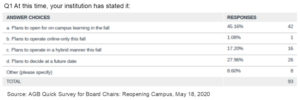
Recently, AGB conducted surveys of four groups of members to gauge how higher education institutions are responding to the COVID-19 pandemic: board chairs, institution presidents, institution board professionals, and foundation board professionals. AGB asked board chairs and institution presidents about their institutions’ plans for reopening in the fall; we asked board professionals what, if any, changes have taken place with respect to the frequency of board meetings and the discussions taking place during those meetings.
AGB learned from these surveys that:
- At this time, less than 50 percent of board chairs and presidents say their institution plans to open for on-campus learning in the fall, and that roughly 25 percent say that the decision will be made in the future.
- While half (52 percent) of governing boards are meeting at their pre-pandemic frequency, nearly as many (45 percent) are meeting more often than usual. Budget/financial scenario planning and fiscal health are the topics boards are spending the most time discussing.
Specifically, the surveys found, in part, that:
- 45 percent of board chairs and 41 percent of presidents say their institutions will open for on-campus learning in the fall;
- 17 percent of board chairs and 29 percent of presidents say their institutions will open for learning in some hybrid manner in the fall; and
- 28 percent of board chairs and 21 percent of presidents say their institutions will decide on reopening for fall at a later date.

These confidential responses are less bullish about welcoming students back to campus this fall than the listing by institution The Chronicle of Higher Education is currently tracking.
With respect to the frequency of board meetings:
- 62 percent of foundation board professionals (BPs) and 52 percent of institution BPs report that their boards meet with the same pre-pandemic frequency, although it is worth noting that 29 percent of foundation BPs and 45 percent of institution BPs report that their boards are meeting more frequently.
- Most institutional BPs report that the chief executive updates the board at least monthly, including 3 percent daily, 37 percent at least once a week, 44 percent 2-3 times per month, and 10 percent monthly.
In terms of what governing boards are discussing at their meetings, foundation BPs report that the most-discussed topics are:
- Budget/financial scenario planning (90 percent);
- Financial health (80 percent);
- Fundraising/capital campaigns (80 percent); and
- Plans for reopening in the fall (35 percent).
College and university BPs report that the most-discussed topics are:
- Budget/financial scenario planning (97 percent);
- Planning for reopening in the fall (81 percent); and
- Financial health (78 percent).
All four surveys point out the significant role that technology plays in remote operations now, and all four also note the importance of increased engagement and communication—and the increased demands on ensuring that operations run smoothly. As one institution board professional notes, “The workload and stress have increased significantly. Each discussion point seems to not have a precedent. People are looking for certainty where none exists. Planning and organizing remote meetings is time- and labor-intensive. And working from home means you are never away from the office.”
Notes another: “Communication with trustees has increased dramatically. Since many are alumni, and some are also parents, their overlapping roles have to be considered. We are sharing information and equipping them to be ambassadors for their institution. Additionally, with the shift to videoconferencing, preparation for meetings has changed completely as has the level of technological support required. We have devoted additional time to the choreography of meeting management to ensure that trustees’ questions and opinions are registered.”
The most immediate challenges higher education institutions are facing revolve around providing education in a safe and healthy environment and safeguarding the financial stability and viability of the nation’s colleges and universities. There are numerous factors that must be considered in moving forward, not the least of which is the eagerness of students and faculty to return to campus. As one president noted, “The main drivers of how we resume operations—beyond state and local ordinances—are student and faculty readiness to return.”
AGB will continue monitoring the response of higher education institutions to the COVID-19 pandemic and provide members with timely updates.
Note: The surveys were distributed to 165 foundation board professionals with a response rate of 12.7 percent (21 respondents); 922 public and private institution board professionals with a response rate of 17.7 percent (163 respondents); 566 public and private presidents with a response rate of 17.5 percent (99 respondents); and 1,117 public and private board chairs with an 8.3 percent response rate (93 respondents).

